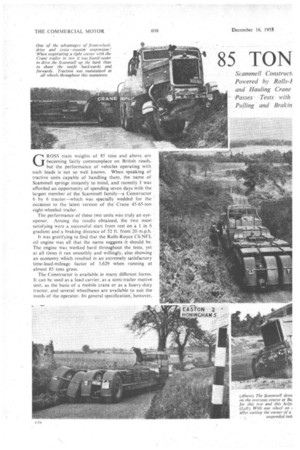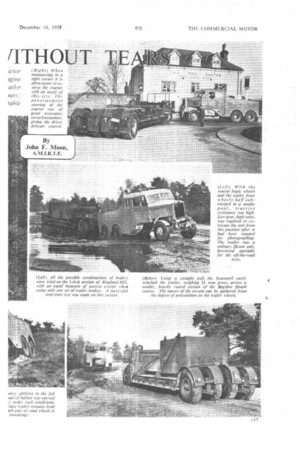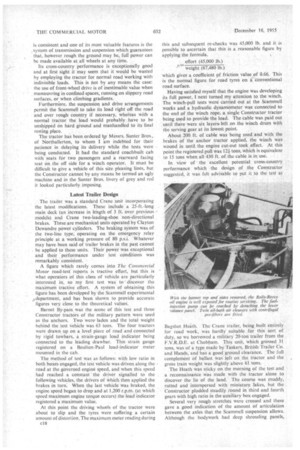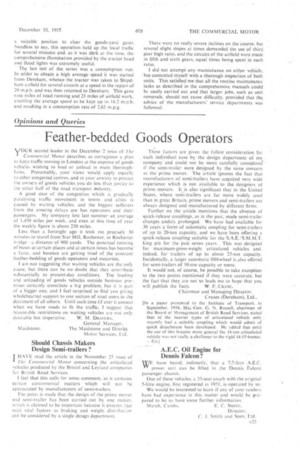85 TON
Page 56

Page 57

Page 58

Page 59

Page 60

Page 63

If you've noticed an error in this article please click here to report it so we can fix it.
11TH GROSS train weights of 85 tons and above are becoming fairly commonplace on British roads. but: the performance of vehicles operating with such loads is not so well known. Wheii speaking of tractive units capable of handling them, the name of Scammell springs instantly to 'mind, and recently I was afforded an opportunity of spending seven days with the largest member of the Scammell family—a Constructor 6 by 6 tractor—which was specially wedded for the occasion to the latest version of the Crane 45-65-ton eight-wheeled trailer.
The performance of these two units was truly an eye• opener. Among the results obtained, the two most satisfying were a successful start from rest on a 1 in 6 gradient and a braking distance of 52 ft.. from 20 m.p.h. • It was gratifying to find that the Rolls-Royce C6.NFL oil engine was all that the name suggests it should be. The engine was worked hard throughout the tests, yet at all times it ran smoothly and willingly, also showing • an economy which resulted in an extremely satisfactory time-load-mileage factor of 3,629 when running at almost 85 tons gross.
The Constructor is available in many different forms. It can be used as a load-carrier, as a semi-trailer motive unit, as the basis of a Mobile crane or as a heavy-duty tractor, and several wheelbases are available to suit the needs of the operator. Its general specification-, however,
is consistent and one of its most valuable features is the system of transmission and suspension which guarantees that, however rough the ground may be, full power can be made available at all wheels at any time.
Its cross-country performance is exceptionally good and at first sight it may seem that it would be wasted by employing the tractor for normal road working with indivisible loads. This is not by any means the case: the use of front-wheel drive is of inestimable value when rnanceuvring in confined spaces, running on slippery road surfaces, or when climbing gradients.
Furthermore, the suspension and drive arrangements permit the Scammell to take its load right off the road and over rough country if necessary, whereas with a normal tractor the load would probably have to be unshipped on hard ground and manhandled to its final resting place.
The tractor has been ordered 1337 Messrs. Sun ter Bros., of Northallerton, to whom I am indebted for their patience in delaying its delivery while the tests were being conducted. It had the standard coachbuilt cab with seats for two passengers and a rearward facing seat On the off side for a winch operator. It Must be difficult to give a vehicle of this size pleasing lines, but the Constructor cannot by any means be termed an ugly machine and in the Sunter Bros. livery of grey and red it looked particularly, imposing.
Latest Trailer Design . The trailer was a standard Crane unit incorporating the latest modifications. These include a 25-ft.-Iong main deck (an increase in length of 3 ft. over previous models) and Crane two-leading-shoe non-directional brakes. These are mechanical units operated by Clayton Dewandre power cylinders. The braking system was of the two-line type, operating on the emergency relay principle at a working pressure of 80 p.s.i. Whatever may have been said of trailer brakes in the past cannot he applied to these units. Their power was exceptional and their performance under test conditions was remarkably' consistent.
A figure which rarely comes into The Commercial Motor road-test reports is tractive effort, but this is what operators of this class of vehicle are particularly interested in, so my first test was to discover the maximum tractive effort. A system of obtaining this figure has been developed by the Scammell experimental ,,department, and has been shown to provide accurate Figures very close to the theoretical values.
Barnet By-pass was the scene of this test and three Constructor tractors of the military pattern were used as the anchors. Two were laden and the total weight behind the test vehicle was 63 tons. The four tractors were drawn up on a level piece of road and connected by rigid towbars, a strain-gauge load indicator being connected to the leading drawbar. This strain gauge registered on a Boulton-Paul load-indicator meter mounted in the cab.
The method of test was as follows: with low ratio in both boxes engaged, the test vehicle was driven along the road at the governed engine speed, and when this speed had reached a constant the driver signalled to the following vehicles, the drivers of which then applied the brakes in turn: When the last vehicle was braked, the engine speed began to drop and at 1,200 r.p.m. (at which speed maximum engine torque occurs) the load indicator registered a maximum value.
At this point the driving wheels of the tractor were about to slip and the tyres were suffering a certain amount of distortion. The maximum meter reading during c18 this and subsequent re-checks was 45,000 lb. and it is possible to ascertain that this is a reasonable figure by applying the formula.
effort (45,000 lb.)
a
' weight (67,480 lb.)
which gives a coefficient of friction value of 0.66. This is the normal figure for road tyres on a conventional road surface.
Having satisfied myself that the engine was developing its full power, I next turned my attention to the winch. The winch-pull tests were carried out at the Scammell works and a hydraulic dynamometer was connected to the end of the winch rope, a single Constructor tractor being used to provide the load. The cable was paid out until there were six layersleft on the winch drum with the serving gear at its lowest point.
About 200 ft. of cable was being used and with the brakes of the anchor tractor applied, the winch was wound in until the engine cut-out took effect. At this point the registered pull was 12-1 tons, which is equivalent to 15 tons when all 430 ft. of the cable is in use.
In view of the excellent potential cross-country performance which the design of the Constructor suggested, it was felt advisable to put it to the test at Bagshot Heath. The Crane trailer, being built entirely for road work, was hardly .suitable for this sort at duty, so we borrowed a military 20-ton trailer from the F.V.R.D.E. at Chobham. This unit, which grossed 31 tons, was of a type made by Taskers, British Trailer Co. and Hands, and has a good ground clearance. The full complement of ballast was left on the tractor and the gross train weight was slightly above 61 tons.
The Heath was sticky on the morning of the test and a reconnaissance Was made with the tractor alone to discover the lie of the land. The course was muddy, rutted and interspersed with miniature lakes, but the Constructor plodded steadily round in, third and fourth gears with high ratio in the auxiliary box engaged.
Several very rough stretches were crossed and these gave a good indication of the amount of articulation between the axles that the Scammell suspension allows. Although the bodywork had deep shrouding panels,
there was sufficient clearance for the tyres and no body damage was sustained. As it proved impossible to get the Scammell stuck when operating solo, we then hitched up the trailer and made a second run around the course.
The going was naturally slower with the additional weight, but was none the less steady--in fact, the way the outfit ploughed on without any apparent regard to the state of the ground was almost uncanny. Only once did it become necessary to use low gear and six-wheel drive thigh ratio in the auxiliary box being engaged the whole time) and this was when the tractor was stopped with the bogie wheels and the leading wheels of the trailer submerged, hub deep. in a muddy pool.
When moving over slippery, muddy sections of the course, the engagement of front-wheel drive was a great help in steadying the vehicle and keeping it on a true course, and this was especially so when turning the unit completely round in a tight circle.
While on the course, a winching exercise was done. The trailer was unhitched in a particularly muddy section of the track and was winched forward despite the high tractive resistance.
These off-the-road trials were impressive but uneventful, and at the end of them I was quite satisfied that it would take a lot more than a 30-ton trailer and the Bagshot mud to halt the progress of the tractor.
The next item on the programme was to take the tractor up to Dereham for tests with the Crane trailer. So that power would not be wasted by carrying an unnecessary amount of ballast, some of the ballast was removed to bring the gross vehicle weight of the tractor, less crew, to 24 tons 7 cwt.
Leaving the Scammell works at 9.55 a.m. with the near-side fuel tank topped up to overflowing, we were c*c.ar of central Watford within five minutes, and at 10.25 a.m. we joined the Al road at Hatfield, having done 131 miles in half an hour. After an hour on the road, we reached the old town of Stevenage-24.5 miles from Watford—and the following six miles to Baldock were covered in a quarter of an hour.
In Baldock, we suffered a slight traffic hold-up because a fellow Scammell Was experiencing slight difficulty in negotiating a very tight corner with a large pressure
cylinder in tow. We then joined A505, and 9 miles on, 25 minutes later we entered Royston, where we had a clear run through the town. Here the roads were flat and it was possible to stay in top gear the whole lime with the road speed varying between 30 m.p.h. and 33 m.p.h. After a long diversion through Towlmere, we stopped for lunch before reaching Newmarket.
After lunch I took over the wheel and although this was my first attempt at driving a vehicle of 8 ft. 6 in. overall width on British roads, I found no difficulty in towns or on busy main Toads. Keeping the speed, whenever possible, well over the " 30" mark. we had an uneventful journey to Dereham, where we arrived at 4.25 p.m., in a running time of 4 hr. 10 min.
Once at Cranes works, the fuel supply was switched over to the off-side tank and later in the test the near-side tank was topped up to overflowing, when it was ascertained that [7.75 gal. of fuel had been used, giving an overall consumption rate of 6.2 m.p.g. for the journey--a very reasonable figure in view of the high average speed and comparative newness of the vehicle.
On the following morning, the trailer was hitched up and the unit was taken out to a disused airfield at Shipdham, where the brakes on the trailer were well and truly rubbed in before I made my braking tests. This was necessary because the trailer had, until that time, not been out. on the road at all.
52 ft. from 20 m.p.h.
The basic brake test consisted of emergency stops from 20 m.p.h.. and these proved to be highly satisfactory. On each occasion a stopping distance of 52 ft. was achieved, with a Tapley meter reading of 50 per cent. There was, naturally enough, a noticeable time-lag in the system, because of the length of the outfit, and the stopping distance was all the more commendable. .
Two further braking experiments were Then conducted, the first of these being a stop from 20 m.p.h. with the trailer brakes disconnected. This sort of test imposes great stress on the drawbar and towing attachment and is a real measure of robust construction. There was no tendency to jack-knife and, although the tractor wheels locked for a slight distance, a maxin,ium Tapley meter reading of 25 per cent. deceleration was recorded.
Reversing the process, a similar stop was made, using the trailer brakes alone, these being applied by means of the tractor hand-reaction valve. On this occasion a 30 per cent. stop was achieved, which is again a creditable figure.
While on the airfield, manoeuvrability tests were carried out. Two sets of turning-circle figures were taken, the first being with front-wheel drive engaged and the second without it On the first occasion the leftand right-hand locks were measured at 85.5 ft. and 88.5 ft. respectively, but smaller circles were achieved without front-wheel drive. Under these conditions the whole outfit was virtually pivoting upon the rear inner wheel of the trailer, which was at times observed to revolve backwards. The tyre scrub was not unreasonable, however, and, in any event, it is unlikely that during normal service such a tight turn would be possible.
Acceleration tests with a unit of this size can properly be carried out only when about a mile of dead-level surface is available: the aerodrome was not completely flat, therefore it was impossible to obtain accurate figures for the complete unit. By averaging out several figures, however, it was discovered that it took approximately 45 sec. to accelerate up to 15 m.p.h. With the tractor running solo, reasonable acceleration figures were achieved, third gear being used from a standing start. Further braking tests of a different nature were carried out the • following day. The only steep hill for many miles in the Dereham area is R ingland Hill, which, although not long, has a section where the average gradient is 1 in 6. It is, however, not easily accessible and I doubted whether the outfit would be able to reach it at all, because of the narrowness of the road and the sharpness of the turns involved. That the combination was indeed threaded through to the hill reflects great credit on both machine and the driver, who in this case was Arthur Williams, of Scarnmell.
We were fortunate in having the co-operation of the local police force, Who proved of great assistance when it was necessary to shunt the outfit across busy main roads. Once on the 1-in-6 gradient, all the possible combinations of brake were tested in turn. These consisted of the tractor air brakes, alone and with the trailer brakes operating; the tractor hand brake alone; the trailer air brakes alone, and the trailer parking (720 brakes alone. In the last of these tests it was necessary to apply the brakes on both axles, but had the tractor not been dragging on the front of the trailer, it is probable that one set of brakes alone would have sufficed.
After a lot of shuffling at the bottom of the hill white turning the outfit completely round, the ascent was made. On the 1-in-6 gradient, low gear (low ratio auxiliary engaged) became necessary, and while in this gear a smooth stop-start test was accomplished. Once. on the move again, the engine quickly ran up to the governed speed and the climb was completed at 2 m.p.h.
Following the hill test, the outfit was taken to the local railway goods yard for weighing, which proved to be several hours' work in itself. The exit from the goods yard entailed a tight left-hand bend, around which it was impossible to drive the complete outfit.
Here, again, the tractor demonstrated its versatility. It was uncoupled, driven across the road into a convenient car park and the trailer was then winched into a suitable position to clear the goods-yard gates. Needless to say, this operation held up the local traffic for several minutes and, as it was dark at the time, the comprehensive illumination provided by the tractor head and flood lights was extremely useful.
The last test of the series was a consumption run, iii ohler to obtain a high average -speed it was started from Dereham, whence the tractor.was taken to Shipdham airfield for several circuits at a speed in the region of 20 m.p.h. and was then returned to Dereham. This gave nine miles of road running and 23 miles of airfield work: enabling the -average speed to be kept up to 16.2 .m.p.h. and resulting in a consumption rate of 2,63 m.p.g.
There were no really severe inclines on the course, but several slight slopes at times demanded the use of third gear high ratio, and the circuits of the airfield were made in fifth and sixth gears, equal times being spent in each ratio.
I did not attempt any maintenance on either vehicle, but.contentedmyself with a thorough inspection of both units. This satisfied me that all the routine maintenance tasks as described in the comprehensive manuals could be easily carried out and that larger jobs, such as unit removals, should not cause difficulty, provided that fihç advice of the manufacturers' service departments was followed.
















































































































